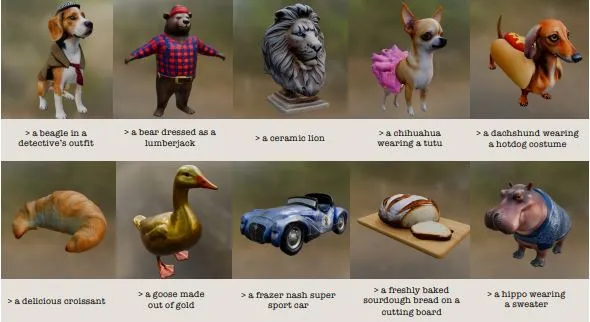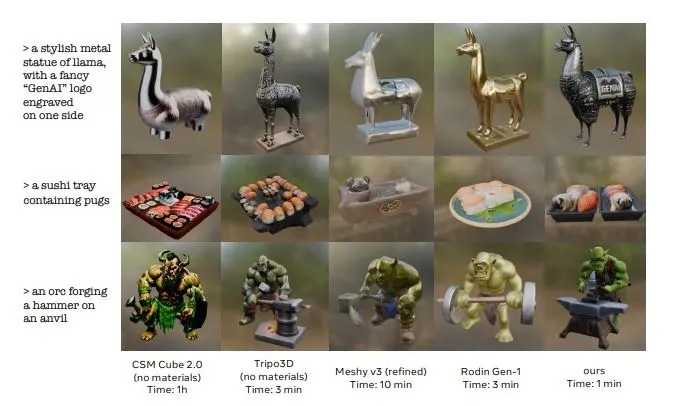Imagine typing a few words and watching a detailed 3D model appear on your screen in less than a minute with Meta’s text-to-3D generator. Sounds like science fiction, right? Yet, 3DGen offers 3D asset creation that feels almost magical. Well, Meta (the company behind Facebook) has just made it a reality with their new AI tool called “3D Gen.”
This amazing technology turns text into high-quality 3D models faster than you can say “virtual reality.” Meta’s 3DGen isn’t just a cool party trick – it could revolutionize how we create everything from video games to virtual home tours through text-to-3D asset generation, providing asset creation with high prompt fidelity.
Let’s dive into what this means for creators, businesses, and maybe even your next social media post.
The Power of Meta 3D Gen

Meta 3D Gen combines two key components:
- Meta 3D AssetGen: Creates 3D meshes
- Meta 3D TextureGen: Generates textures
These technologies work together to produce 3D assets with high-resolution textures and physically based rendering (PBR) materials. The system creates detailed 3D models complete with colors and patterns. It rivals the work of professional 3D graphics artists in both quality and speed, thanks to its advanced generative AI.
Speed and Efficiency
Meta 3D Gen operates at an impressive pace:
- 3-10 times faster than previous solutions, using assetgen and Meta 3D texturegen technology
- Generates 3D assets in less than a minute with prompt fidelity and high-quality 3D shapes
- Produces textures in under a minute
This speed could streamline workflows across multiple industries. It reduces production time and costs. It also enhances creative possibilities through efficient 3D asset creation with high resolution.
Technical Innovations
Meta 3D Gen incorporates several advanced features:
- High-Resolution Textures: Generates detailed, high-quality textures for complex 3D geometries, perfect for advanced 3D asset creation with high clarity.
- PBR Materials: Supports physically based rendering for realistic relighting of objects.
- Texture Enhancement: Upscales textures to 4K resolution, enhancing the overall quality of 3D objects created by 3DGen.
- Two-Stage Approach: Combines text-to-3D and text-to-texture generation for superior quality.
The system can create a diverse array of 3D models and 3D objects within a single object class through 3DGen technology. It offers high prompt fidelity. The output includes high-quality 3D shapes and textures.
Potential Applications

Meta 3D Gen has the potential to reshape numerous industries through its assetgen and Meta 3D texturegen:
Gaming and Virtual Worlds
- Enables rapid prototyping of environments and assets
- Accelerates development of expansive virtual worlds through efficient 3D asset creation with high productivity.
Architecture and Industrial Design
- Allows quick visualization of concepts
- Improves communication with clients through rapid 3D model generation
Augmented and Virtual Reality
- Lowers barriers to creating high-quality 3D assets
- Speeds up development of immersive experiences
Marketing and Advertising
- Enhances promotional content with 3D animations
- Improves product visualization for e-commerce
Product Design
- Facilitates faster design iterations
- Enables quick visualization of design tweaks
Comparison to Existing Technologies

Meta claims 3D Gen outperforms competing text-to-3D models in quality and speed, using asset creation with high prompt fidelity. Professional 3D artists have preferred Meta’s technology in feedback sessions. The system separates mesh models and texture maps. This allows for significant control over the final output. It enables iterative refinement similar to text-to-image generators.
Unique Features
Meta 3D Gen offers several unique capabilities:
- Generates diverse 3D models within a single object class
- Produces high-resolution textures and material maps
- Supports PBR materials for realistic integration into existing workflows
- Allows for texture enhancement to 4K resolution
- Enables quick iterations and adjustments based on user feedback
Real-World Examples
Meta has showcased various examples of 3D Gen’s capabilities:
- A raccoon holding a pizza slice
- A sweet pastry with convincing icing
- A butterfly with long antennae
- Dragon eggs with lifelike textures
- Bears in various outfits
- A sculpture in Van Gogh’s style, brought to life using 3DGen’s text-to-3D asset generation.
- A hybrid armadillo-turtle creature
- An array of llama models in different styles
These examples demonstrate the system’s versatility and ability to produce both realistic and fantastical 3D assets.
Implications for the Industry
While Meta 3D Gen represents a significant advancement, it raises questions about the future of 3D modeling:
- Could enhance the productivity of 3D artists
- Might reduce demand for routine 3D asset creation
- May push professionals towards more creative and complex work
- Could democratize 3D content creation
- Might accelerate innovation across multiple industries
Looking Ahead
Meta 3D Gen is currently a research product. It has no fixed public release date. However, its development signals a clear trend. We’re moving towards more sophisticated AI tools in 3D graphics creation.
As AI evolves, we can expect more tools bridging AI-generated content and professional 3D workflows. This could revolutionize industries from game development to industrial design.
The full impact of Meta 3DGen remains to be seen. But one thing is clear: AI is transforming 3D asset creation. It’s opening new avenues for creative expression in the digital realm.
For now, Meta 3D Gen may be seen as a tool to augment human creativity. It could coexist with human artists, potentially boosting their work. But questions remain about the long-term impact on the 3D graphics industry.
As this technology develops, it will be crucial to monitor its effects on professional 3D artists. We must also consider its potential to democratize 3D content creation. The future of 3D graphics is rapidly changing, with AI and creation with high prompt fidelity at the forefront of this transformation.
Copy
FAQ’s
What is procedural generation of 3D models?
Procedural generation creates 3D models using algorithms and rules rather than manual modeling. Meta’s 3D Gen takes this concept further by using AI to generate 3D models from text descriptions, offering a new level of automation and creativity.
How can I download 3D assets from text models?
While Meta’s 3D Gen is not yet publicly available, it represents a potential future where 3D models can be generated on-demand from text prompts. Currently, you can download 3D models from online marketplaces, but AI tools like 3D Gen may change this landscape.
Is 3D modeling free?
While there are free 3D modeling tools available, Meta’s 3D Gen represents a potential shift in the industry due to its creation with high prompt fidelity. It could make high-quality 3D asset creation more accessible, potentially reducing the need for expensive software or specialized skills.
How does Meta’s 3D Gen differ from traditional 3D modeling tools in terms of generation with high-quality geometry?
Meta’s 3D Gen uses AI to generate 3D models from text descriptions, unlike traditional tools that require manual modeling. It can produce high-quality assets with textures and PBR materials in under a minute, significantly faster than manual methods.
What industries could benefit from Meta’s 3DGen and its text-to-3D asset generation technology?
Meta’s 3D Gen could potentially benefit industries such as gaming, virtual reality, architecture, product design, and advertising, thanks to its 3D assets from text capability. It could speed up asset creation, prototype development, and visualization processes across these sectors.
Will Meta’s 3D Gen replace professional 3D artists?
While Meta’s 3D Gen is a powerful tool, it’s likely to augment rather than replace professional 3D artists. It may automate certain tasks, but human creativity and expertise will still be crucial for complex, custom work and creative direction.


